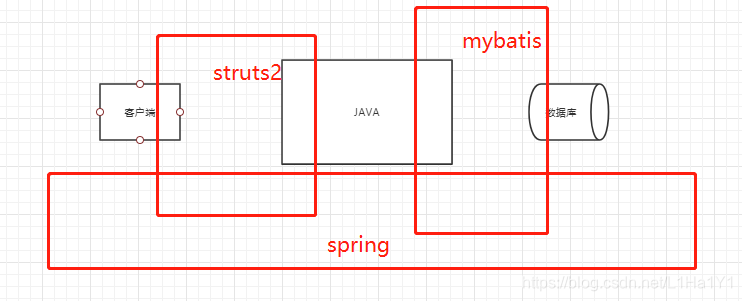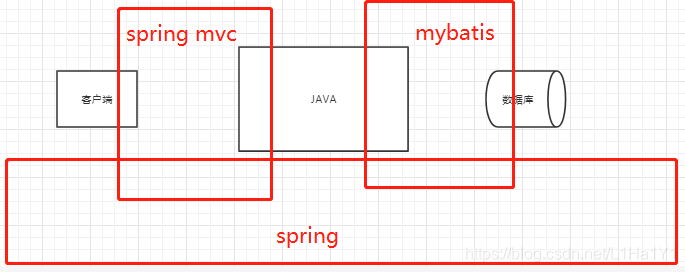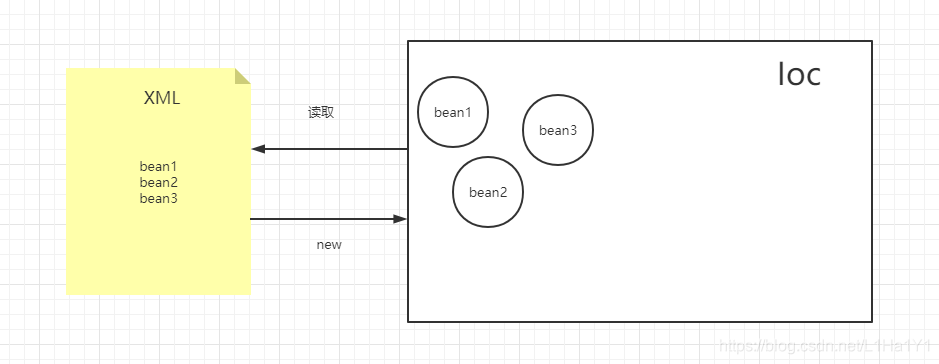1 Spring
Java领域的第一框架,是行业标准和规范。Java初期使用EJB开发,但是这种方式非常繁重,不灵活,不便于维护和升级。经过20年的发展,Spring框架已经从最初取代EJB构建企业级开发的方式,发展成一套自有的生态体系。
Spring框架是指Spring Framework,Spring Framework是整套Spring全家桶所以产品的基石,所有组件产品都是基于Spring Framework,IoC容器。
Spring 有两大核心组件:
- Ioc 控制反转
- Aop 面向切面编程
1.1 SSH框架
structs2(实现MVC,客户端和服务器的交互)、Spring(构建项目)、Hibernate(持久层)

1.2 SSM框架
Spring MVC、Spring、Mybatis

2 Spring Ioc
控制反转(Inversion of Control),反转的是Java程序中对象的创建方式,传统开发是开发者需要的时候new一个对象出来,而控制反转不需要开发者手动new,而是交给IoC容器来创建,开发者可直接使用

1、传统开发方式
public class test01 {
public static void main(String[] args) {
//传统方式创建对象
Card card = new Card();
card.setCNO("sx010");
card.setNAME("宝乐");
card.setCLASS("c03");
System.out.println(card);
2、IoC
<bean id="card1" class="com.eleven.entity.Card">
<property name="CNO" value="sx011"></property>
<property name="NAME" value="历飞雨"></property>
<property name="CLASS" value="c03"></property>
</bean>
public static void main(String[] args) {
ApplicationContext applicationContext = new ClassPathXmlApplicationContext("spring.xml");
Card card1 = (Card) applicationContext.getBean("card1");
System.out.println(card1);
2.1 IoC使用流程
- 将程序需要的对象在spring.xml配置文件中配置(两种配置方式)
无参构造( property ):通过setter方法完成赋值,实体类必须有无参构造)
<bean id="card1" class="com.eleven.entity.Card">
<property name="CNO" value="sx011"></property>
<property name="NAME" value="历飞雨"></property>
<property name="CLASS" value="c03"></property>
</bean>
有参构造( constructor-arg ):实体类必须有有参构造
<bean id="card1" class="com.eleven.entity.Card">
<constructor-arg name="CLASS" value="C05"></constructor-arg>
<constructor-arg name="CNO" value="sx004"></constructor-arg>
<constructor-arg name="NAME" value="大宝乐"></constructor-arg>
</bean>
- 读取 spring.xml 文件 生成 ApplicationContext对象(IoC容器)
ApplicationContext applicationContext = new ClassPathXmlApplicationContext("spring.xml");
3.从ApplicationContext对象中获取需要的bean(两种获取方式)
- 通过id获取 (spring.xml中配置的id必须唯一)
Card card1 = (Card) applicationContext.getBean("card");
- 通过Class类型获取(必须保证配置文件中只有一个该类的bean)
Card card1 = (Card) applicationContext.getBean("Card.class");
2.1 IoC的DI
bean之间的依赖注入叫做DI,IoC包含DI,IoC可以自动完成依赖注入,把一个bean注入到另一个bean中
1.传统开发方式
public static void main(String[] args) {
Card card = new Card();
card.setNAME("王宝乐");
card.setCNO("sx001");
card.setCLASS("c04");
Student student = new Student();
student.setId(1);
student.setName("土匪");
//传统依赖注入 DI
card.setStudent(student);
2.ioc方式 :使用 ref 完成依赖注入
<bean id="card" class="com.eleven.entity.Card">
<constructor-arg name="CLASS" value="C05"></constructor-arg>
<constructor-arg name="CNO" value="sx004"></constructor-arg>
<constructor-arg name="NAME" value="大宝乐"></constructor-arg>
<constructor-arg name="student" ref="stu1"></constructor-arg>
</bean>
<bean id="stu1" class="com.eleven.entity.Student">
<property name="id" value="1"></property>
<property name="name" value="吴亦凡"></property>
</bean>
3.多bean依赖注入 使用 list 完成依赖注入
<bean id="stu1" class="com.eleven.entity.Student">
<property name="id" value="1"></property>
<property name="name" value="吴亦凡"></property>
</bean>
<bean id="stu2" class="com.eleven.entity.Student">
<property name="id" value="2"></property>
<property name="name" value="鹿晗"></property>
</bean>
<bean id="stu3" class="com.eleven.entity.Student">
<property name="id" value="3"></property>
<property name="name" value="张艺兴"></property>
</bean>
<bean id="cla" class="com.eleven.entity.Class">
<property name="id" value="1"></property>
<property name="name" value="一班"></property>
<property name="students">
<list>
<ref bean="stu1"></ref>
<ref bean="stu2"></ref>
<ref bean="stu3"></ref>
</list>
</property>
</bean>





 本文深入探讨了Spring框架作为Java领域第一框架的地位及其发展历程,详细解释了Spring框架的两大核心组件Ioc控制反转和Aop面向切面编程的概念,以及如何在实际开发中应用Spring Ioc进行对象管理和依赖注入。
本文深入探讨了Spring框架作为Java领域第一框架的地位及其发展历程,详细解释了Spring框架的两大核心组件Ioc控制反转和Aop面向切面编程的概念,以及如何在实际开发中应用Spring Ioc进行对象管理和依赖注入。
















 231
231

 被折叠的 条评论
为什么被折叠?
被折叠的 条评论
为什么被折叠?








